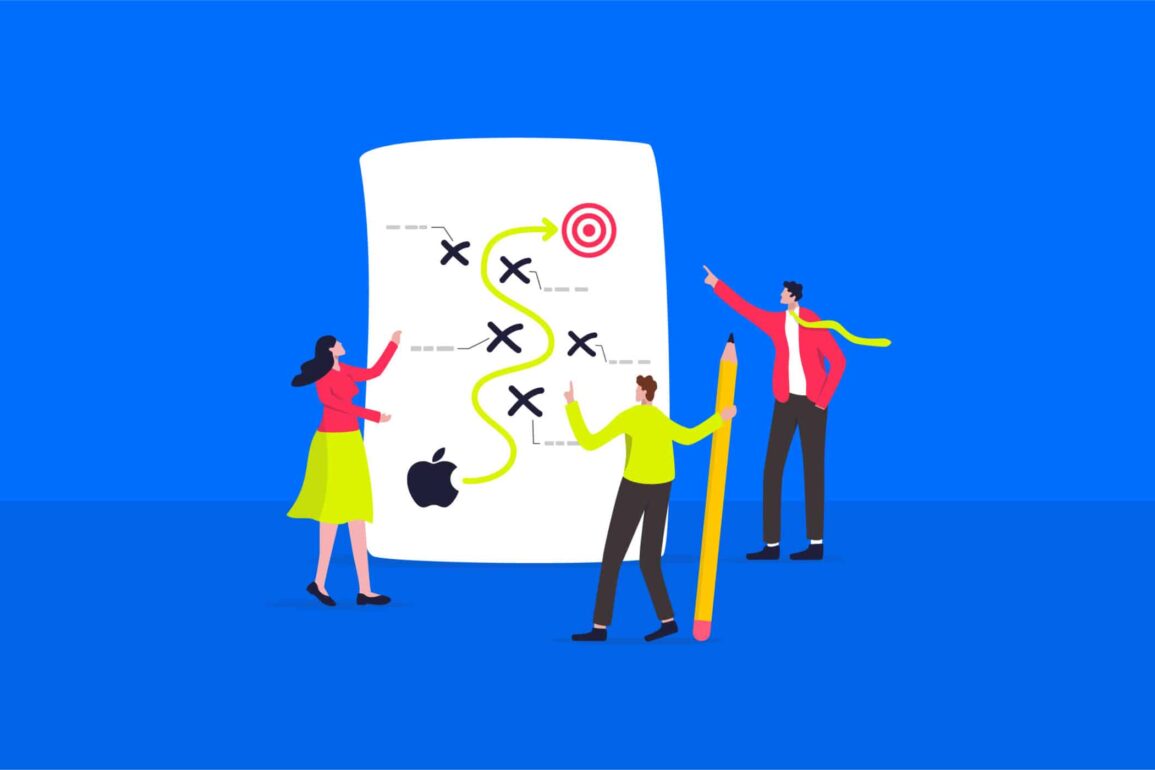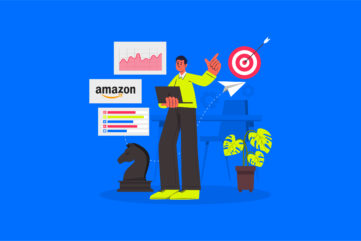Apple’s brand positioning strategy, segmentation and targeting

Apple’s brand positioning strategy is one of the world’s best examples of how the right brand and marketing mix can generate success.
Over the years, this world-famous brand has cultivated an almost cult-like following among its customers. It’s all thanks to the production of not just phenomenal products but also amazing services and ad campaigns.
Every aspect of the Apple brand positioning strategy highlights the company’s core values, its unique benefits to the market, and its status as an innovator.
Apple products and services are created with phenomenal attention to detail, addressing key pain points in the market and constantly differentiating the company from its competitors.
For years, Apple has successfully enhanced its reputation, becoming one of the world’s most well-known providers of personal computers and technology systems.
In fact, between 2004 and 2020, Apple increased its revenue from $8 billion to over $2,200 billion, thanks primarily to its unique marketing strategies and brand image.
So, how did Apple achieve such phenomenal success?
Today, we’re taking a closer look at Apple’s brand positioning strategy, marketing mix, and customer segmentation strategies to learn more about this world-renowned brand.
The brand positioning of Apple: An introduction
One of the things that make the Apple brand positioning unique is that the company has established itself not just as a technology innovator but as a lifestyle brand too.
While Apple is certainly perceived as an innovative and adventurous company, thanks to its constant commitment to innovation, it’s also seen as a business that puts the needs of its customers first.
The brand positioning of Apple highlights how the organization has responded to the changes in the technology industry over the years.
As the tech landscape has transformed, and “digital transformation” occurs at an accelerated rate, it’s no longer enough for businesses to be seen as simply innovative. To stand out as a thought leader, businesses like Apple need to position themselves as champions for their unique target audience.
Primarily, Apple’s brand positioning identifies the company as a premium brand sought out by tech-savvy and image-conscious individuals around the world. The Apple Inc. organization aims to create an emotional connection with its audience by selling “experiences” instead of just products.
Through extensive research into the pain points and core values of its customers, Apple has created an agile, ever-evolving business capable of putting the customer experience first.
The brand not only produces the most powerful new products on the market, with consistent investment in research and development, but it also promises customers a way to enhance their identity.
Every aspect of the business is built to enhance experiences. The events hosted by the brand are informative and inspirational. The teams chosen to work with the Apple brand deliver exceptional, high-quality support to every customer.
Even the marketing strategies used by the business focus heavily on the benefits customers can get from each item.
Apple’s brand positioning statement
The Apple brand positioning statement focuses on a few core factors: technological innovation and advancement, sustainability, and customer-centricity:
“Apple emphasizes technological research and advancement and takes an innovative approach to business best practices — it considers the impact our products and processes have on its customers and the planet.”
The Apple brand promise, mission, and vision
Apple’s objectives as a technology company are driven by carefully refined mission statements, visions, and values. The promise of the company is two-sided.
On the one hand, the business guarantees to create products that can transform the world through innovation and discovery. On the other hand, Apple also inspires and empowers its customers.
Apple doesn’t just want to produce the next generation of technology; it wants to motivate its customers to look at the world through a new lens. This focus influences everything from the company’s product design strategy to its marketing plan.
Let’s take a closer look at some of the core components that drive Apple marketing strategies:
The Apple mission statement
The Apple corporate mission statement revolves around championing technical innovation, excellence, and customer service. The brand wants to support and empower customers around the world with technology that actively delivers valuable results.
The corporate mission statement is:
“To bring the best personal computing products and support to students, educators, designers, scientists, engineers, businesspersons, and consumers in over 140 countries around the world.”
Apple’s mission statement highlights the company’s commitment to delivering the best possible products available. It focuses not just on the world of mobile phones and personal computers, but all “computing products” capable of benefiting today’s consumers.
The Apple vision statement
Apple’s brand positioning strategy revolves heavily around its underlying vision. The company wants to “make the best products on earth and leave the world better than we found it.” This vision demonstrates Apple’s commitment to holding itself to a higher standard than its competitors.
The brand wants to make not just the best products in the world but the solutions that are best for the world, with a focus on user experience and sustainability in the technology industry.
Apple acts on its vision statement by producing exceptional experiences for customers and committing to sustainable and socially responsible practices.
Apple’s core values
Apple’s core values dictate how the business and its employees operate. The values championed by the company make a huge difference to the positioning of Apple and how the business retains a strong brand identity.
Some of the core values of Apple include:
Accessibility
Apple focuses on making its Mac computers, phones, and even Apple TV services as easy to access and user-friendly as possible. Developers can even access the Apple app store ecosystem to build their own applications.
Transformation
The tech giant also focuses on empowering people who need access to more solutions in the technology industry. The brand gives products, support, and opportunities to schools and educational facilities.
Social responsibility
Apple is carbon neutral and working to make all of its products with clean energy and resources to reduce its carbon footprint. The company is also consistently strengthening its commitment to making the workplace more inclusive, with a focus on equality and support for people from all backgrounds.
Privacy
Apple believes privacy is a human right and therefore designs its products to protect customer information and give them more control over their data. In 2021, Apple even updated its privacy controls to help customers see when apps are using their data.
Partnerships
Apple holds its suppliers and partners to the same standards as its own team. The company conducts rigorous supplier performance assessment processes and focuses heavily on eliminating partnerships with unsustainable companies.
Apple’s positioning strategy: The Apple target audience
Apple’s target market is another core component of the company’s positioning strategy. Apple’s positioning strategy focuses on attracting specific customers with unique needs.
Primarily, the company positions itself as a high-quality brand, which means its products feature premium prices and are often more expensive than competing solutions.
However, Apple is working to make its solutions more accessible.
Customers can reduce the high price of an Apple smartphone by trading in their own devices. Additionally, the business ensures customers get value from their purchases by ensuring Apple products are long-lasting, durable, and packed with the latest technology and innovations.
From a demographic perspective, the Apple target audience generally focuses on people between the ages of 18 and 45 from all family backgrounds.
Although Apple products appeal to a wide range of customers, the audience does skew towards the female community, with around 66% of all Apple customers identifying as female.
Additionally, while Apple products are user-friendly enough to be leveraged by people of virtually all ages, younger customers are more drawn to the brand’s innovative approach.
Apple’s marketing strategy and positioning campaigns make the company particularly appealing to millennials, Gen Z, and other younger consumers.
Apple market segmentation: Apple’s customer segments
Diving a little deeper into the Apple target audience, we can see how the company segments its customers based on behavioral, psychographic, and geographic factors. Today, Apple is a global brand with product lines all over the world, appealing to a wide range of customers.
However, the business does have a competitive advantage in some sectors.
Apple’s geographic segmentation
As a global brand, Apple connects with customers all over the world. However, the biggest target customer segment for the company is in the United States. American consumers earned the business around $37 billion in net sales during the third quarter of 2022.
Although they’re not as valuable to the company as America, countries like Europe and China are also crucial to Apple’s target market.
In terms of geographic variables, Apple has outlets in regions across the world, as well as a strong online presence. Apple has set up a number of physical retail stores, all of which retain a consistent visual identity, helping to give the business a strong in-person identity.
Apple’s behavioral segmentation
Apple primarily targets companies that are interested in experimenting with technology and mobile experiences. The Apple retail stores focus heavily on highlighting the benefits of the smartphones offered by the brand and even provide customers with a way to browse the app store.
From a behavioral perspective, Apple’s target customer segment has a strong interest in gaming and software.
The Apple app store contributes a significant amount of revenue to the company each year. Additionally, it allows Apple to appeal to a range of customers, including families looking to purchase educational apps and tools for their children.
Apple psychographic segmentation
Though Apple’s target audience is generally made up of people with higher earnings than most, Apple’s customers are typically financially stable and don’t take a lot of risks. They enjoy the comfort of the Apple brand and the stability and quality it represents.
Apple customers also take advantage of the extra support offered by the brand at premium prices to protect their investments.
Apple customers are aspirational and ambitious individuals with a higher income status. They’re also highly invested in preserving their personal image. One study found Apple users spend around $117 per month on average and around $83 per month on makeup.
What is Apple’s marketing strategy? The Apple marketing mix
Marketing at Apple focuses heavily on positioning products as the best solution to a customer’s specific pain points and needs. The Apple positioning strategy revolves around highlighting value, unique experiences, and excellent quality.
If we take a closer look at the Apple marketing mix, we can see that the company has prevented itself from getting into a “price war” with other brands by combining high costs with exceptional quality. Here are the core elements of the Apple marketing mix:
The Apple product strategy
Apple produces premium products for the technology industry. It invests in hardware development, with Apple computer products and smartphone technology. However, Apple also explores the software landscape with solutions like Apple Music and the app store.
The company’s product lines consistently evolve over time to meet the ever-changing needs of its customers. One of Apple’s core brand values is innovation, and it constantly commits to researching and developing new solutions for the electronics industry.
Crucially, Apple spends a lot of time refining and updating its products rather than producing brand-new items. Solutions like the iPhone are updated rather than redesigned each year.
The Apple pricing strategy
In the marketing mix of Apple, pricing is an important factor. Apple has always positioned itself as a premium brand, offering exceptional quality and innovation for a matching price.
While Apple’s products are more expensive than the other options available on the market, they appeal to customers as more than just a tech investment. People see Apple products as a status symbol.
Apple never lowers its prices to fight against competitors, as it believes this will dilute its image as a high-end technology vendor.
While Apple’s pricing may prevent it from reaching some new customers, it also helps the organization retain the loyalty of its existing clients, who see the company’s products as a way of boosting their own image.
The Apple placement strategy
From a placement perspective, Apple retains a strong market share by making its solutions available in locations all over the globe. The business uses numerous distribution channels to serve the needs of customers, including online and offline sales.
Apple has its own dedicated stores in different locations, branded to match the company’s image.
At the same time, Apple sells its products through a variety of different retailers and online portals, such as Amazon. Apple hand-picks the corporate resellers it works with based on the size of the store, its monthly sales, and other factors.
The Apple promotion strategy
Positioning Apple items as the best solution on the market requires the company to take an innovative approach to promotion. Apple focuses on aggressive advertising across various channels, such as online advertising, television, and even industry events.
The company works hard to come up with creative and innovative marketing campaigns, such as the “Think Different” campaign, which highlights the unique nature of the company.
Apple works with influencers and thought leaders in its field to connect with customers and share its brand purpose. It also uses a consistent tone of voice in its marketing, focused on modernity and thought leadership.
Apple keeps things simple with its ads, focusing on providing customers with inspirational, motivational content, which eliminates unnecessary information.
Marketing at Apple: Core Apple marketing objectives
Over the years, Apple has used various marketing strategies to reach new markets, showcase different products, and connect with its loyal customers. While the company frequently experiments with new campaigns across different mediums, it does focus heavily on consistency.
The company’s brand identity, from its sleek visual design to its easy-to-follow messaging, shines through in everything the organization does.
What’s more, Apple retains a commitment to transparency, creating a buzz with famous events, sharing valuable content online, and making sure everyone can access the right information about its electronic products.
The Apple marketing objectives revolve around educating and inspiring customers with a modern approach to each campaign. Some of the core factors of the company’s marketing strategy include:
Simplicity
Apple’s marketing strategies are never complex or confusing.
Ease of use is one of the core benefits offered by Apple products, and the business aims to highlight this in its marketing strategies. In Apple marketing campaigns, there aren’t any long feature lists, colorful graphics, or special effects designed to distract from the actual benefits of the products.
On every channel, from social media to television, Apple keeps its campaigns sleek and simple. It uses market research into potential customers to discover the deepest needs of its target market, so it can position itself as the perfect solution to their problems in simple terms.
Consistency
As mentioned above, while Apple does experiment with different print ads, social media campaigns, and video strategies, it maintains a highly consistent identity.
It constantly highlights itself as being different from its competitors, with ads specially created to help people understand why its solutions are more expensive but also more valuable than alternative solutions.
Apple’s visual identity plays an important role in its marketing strategy, influencing everything from the way campaigns are designed to how products are promoted on the Apple website.
Experience
Apple positions its solutions as more than just products: they’re experiential solutions. Apple users don’t just get access to innovative and stylish technology. They invest in becoming a part of a community experience.
The company uses the art of storytelling to help customers envision what it’s like to be an Apple owner and picture their ideal selves.
Similarly, every purchasing and marketing experience is carefully crafted. Apple stores are designed to feel modern and futuristic. The company’s commitment to serving its customers with access to “Genius” assistance highlights its focus on delivering great support.
Every part of the Apple strategy is intended to make customers fall in love with the experience of being an Apple buyer.
Personality
Apple’s personality is one of an innovator, creator, and forward-thinker. It resonates with customers who want other people to see them as tech-savvy and stylish. While Apple produces educational content for its audience, it consistently commits to speaking their language.
You won’t find complicated jargon in Apple ads and promotions. All of the language used is simple and easy to understand. The company’s business leaders speak to customers like friends and equals rather than using complicated terminology.
With this personality, Apple highlights its commitment to putting its customers first.
Style
Finally, Apple is a huge believer in the importance of style and aesthetics. Everything about the company’s visual identity screams sophistication and modernity. The company’s stores are designed carefully to provide a unique visual experience to customers.
Products are developed to be as sleek and contemporary as possible.
Many of Apple’s marketing campaigns are also highly visual, leveraging amazing photos, videos, and other elements to capture the attention of a style-focused audience.
Learning from Apple’s brand positioning strategy
Apple’s brand positioning strategy is an excellent insight into how companies can connect with customers on a deeper level through a dynamic personality, exceptional aesthetics, and strong core values.
The company is more than just a technology brand; Apple is a company that speaks to customers in their language, empowering them to create the ideal image for themselves.
Apple’s commitment to empowering its customers has helped it to earn a cult-like following of dedicated, loyal clients over the years.
Its marketing and positioning strategy also ensures customers are comfortable paying premium prices for products because they believe they’re getting what they pay for.
Even as endless new technology companies emerge into the market, offering similar products and solutions to Apple, the company retains its position as an innovator and original thinker. It refuses to adapt to the status quo and inspires customers to walk their path.
Fabrik: A branding agency for our times.





















